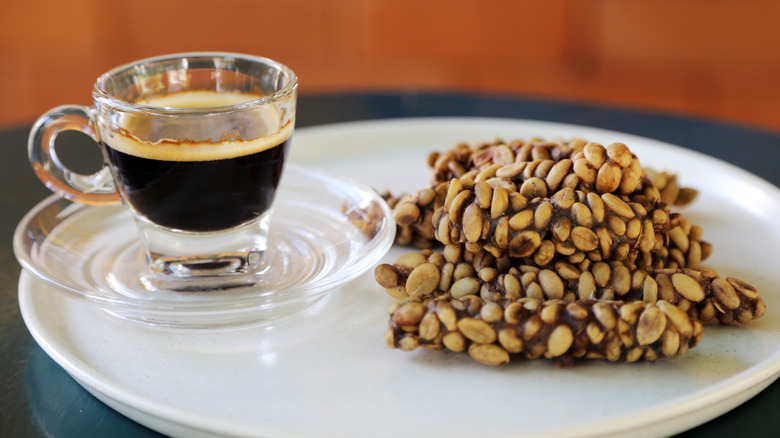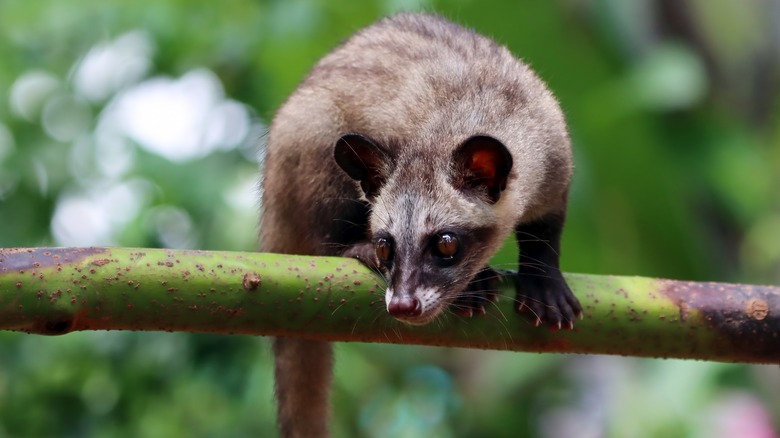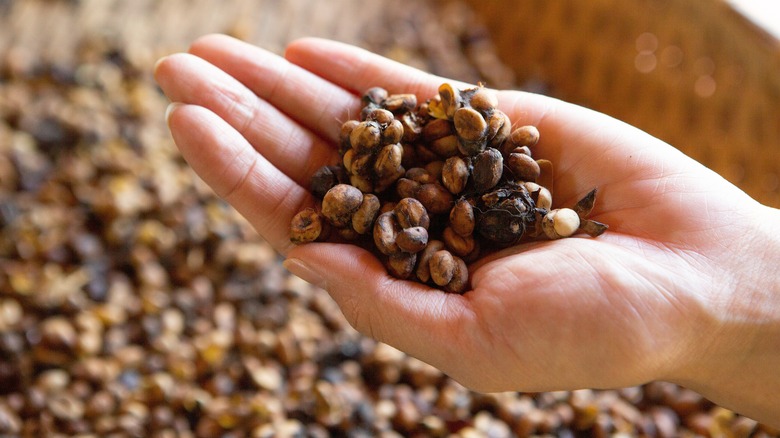The Unexpected Process Behind Kopi Luwak, The World's Most Expensive Coffee
The term "Kopi Luwak" likely doesn't mean anything to those of us who aren't coffee fans, but the definition of the term is something you would never expect. It literally translates to "civet coffee" in Indonesian, and refers to a unique process for making coffee that was invented in the country. The Kopi Luwak method is a bit unconventional, but the resulting coffee is highly regarded and sought-after — in fact, it's widely considered to be the world's most expensive coffee.
What makes it unconventional? Well, Kopi Luwak is also called "cat poop coffee." When an animal called palm civets – which are not a species of cat, but resemble one – eat coffee fruits, then poop it out, the partially digested coffee cherry (and its seeds, the coffee beans) are harvested to make Kopi Luwak.
The civet themselves give Kopi Luwak its unique characteristics. When these small creatures eat coffee cherries, enzymes in their stomach cause a kind of fermentation in the coffee cherries and their beans, removing some bitterness and enhancing the amount of citric acid in the fruit. This accounts for the smooth flavor and signature lemony tang associated with this highly-valued category of coffee. The beans are then harvested and (thankfully) thoroughly cleaned, with the beans' outer skins taken off before roasting.
Why Kopi Luwak coffee is so expensive
The increasing demand for Kopi Luwak coffee is a significant factor in its exorbitant pricing. How exorbitant? One cup of this unusual coffee can sell for up to $100. The worldwide market for Kopi Luwak, meanwhile, was calculated at $6.5 billion as recently as 2021, and it's projected to hit $10 billion by 2030.
Perhaps the biggest factor the price is the scarcity and labor-intensive nature of producing this coffee using traditional methods. Kopi Luwak is considered one of the rarest types of coffee. In 2014, the annual production of Kopi Luwak was estimated to be less than 300 pounds, mainly coming from countries like Indonesia and the Philippines. Even so, this figure was thought to be vastly underestimated. As demand has surged, so too have counterfeit and less sustainably-sourced versions of Kopi Luwak.
A distinction was eventually drawn between traditional, sustainably-sourced, "wild" Kopi Luwak and similarly-labeled coffees that come from caged civets, per the BBC,. It's now widely believed that much of the Kopi Luwak on the market is either counterfeit, contains a low percentage of actual Kopi Luwak beans, or is produced nontraditionally and possibly unethically.
The controversy of modern Kopi Luwak
Kopi Luwak coffee cannot be made without the digestive contributions of palm civets, and while harvesting the feces of wild civets is a sustainable practice, some coffee makers have attempted to cash in on the high prices for Kopi Luwak by caging civets in an inhumane fashion and feeding them a diet of nothing but coffee cherries to ramp up production.
Unfortunately, there are no regulations or certifications to help consumers discern whether the product they're buying is authentic and ethically sourced. However, there are notable producers of Kopi Luwak who do make a point of promoting their organic practices and use of free-range civet byproducts. There is also no reliable way to tell the wild Kopi Luwak coffee from its many imitators, although checking the color of the beans does provide some clues. Real Kopi Luwak beans tend to be darker and have a more reddish color, according to a 2005 study published in Food Research International.



